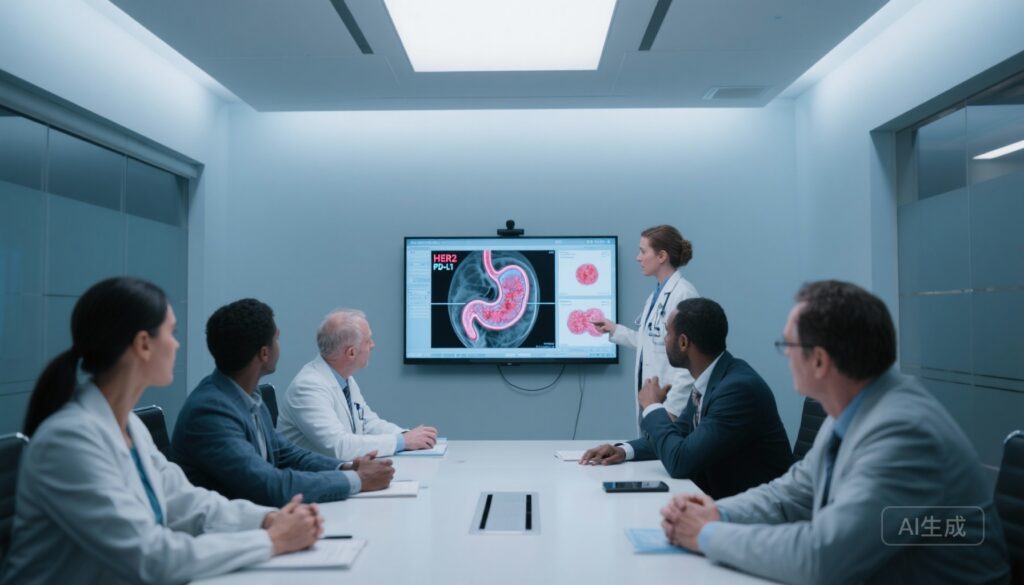Highlights
– The IKF/AIO PHERFLOT phase 2 trial reports a 48.4% pathological complete response (pCR) rate (15/31) with perioperative pembrolizumab, trastuzumab and FLOT in localized HER2‑positive esophagogastric adenocarcinoma (intent‑to‑treat).
– Major pathologic response (pCR + TRG1b) was 67.7% (21/31); 30 of 31 patients proceeded to R0 resection.
– Grade ≥3 treatment‑related adverse events occurred in 48.4% (15/31) without treatment‑related deaths; safety aligned with expected profiles of chemotherapy, anti‑HER2 therapy and anti‑PD‑1 blockade.
Background
Localized esophagogastric adenocarcinoma remains a major cause of cancer mortality worldwide. For resectable disease, perioperative or neoadjuvant chemotherapy improves resection rates and survival compared with surgery alone. The FLOT regimen (5‑FU/leucovorin, oxaliplatin and docetaxel) is an accepted perioperative standard for gastric and gastroesophageal junction adenocarcinomas, improving outcomes versus older triplet regimens in randomized studies.
HER2 overexpression/amplification defines a biologically and therapeutically actionable subset in gastroesophageal adenocarcinoma. Trastuzumab established benefit in the metastatic setting when combined with platinum‑fluoropyrimidine chemotherapy. Separately, immune checkpoint inhibition targeting PD‑1 has shown clinically meaningful activity in gastroesophageal cancers, particularly in tumors with higher PD‑L1 expression or other permissive immune features (and in the adjuvant setting for esophageal/GEJ cancers following neoadjuvant chemoradiation).
Given biologic rationale for synergy—chemotherapy can increase antigen release and modulate the tumor microenvironment, trastuzumab can mediate antibody‑dependent cellular cytotoxicity and potentially increase immune visibility, and PD‑1 blockade can release adaptive immune suppression—combination perioperative strategies targeting HER2 and PD‑1 added to cytotoxic chemotherapy are an attractive approach to deepen responses prior to surgery and improve long‑term outcomes.
Study design (PHERFLOT, interim analysis)
PHERFLOT is an open‑label, single‑arm phase 2 trial (IKF/AIO) evaluating the safety and antitumor activity of adding pembrolizumab and trastuzumab to perioperative FLOT chemotherapy in patients with localized HER2‑positive (IHC3+ or IHC2+/ISH+) esophagogastric adenocarcinoma. Key primary endpoints are pathological complete response (pCR) rate and 2‑year disease‑free survival (DFS). Secondary endpoints include R0 resection rate, feasibility and safety. Exploratory analyses examine response patterns by biomarkers such as HER2 IHC intensity, PD‑L1 combined positive score (CPS), and baseline tumor stage.
The interim analysis reported here includes the first 31 enrolled patients with a median follow‑up of 14.8 months; only the pCR endpoint and select feasibility/safety outcomes are mature enough for reporting at this time.
Key findings
Patient disposition and surgical outcomes
Thirty‑one patients were enrolled. After four cycles of neoadjuvant pembrolizumab + trastuzumab + FLOT, 30 patients proceeded to surgery and achieved R0 resection; one patient declined surgery despite no progression on therapy. The R0 resection rate is therefore high, and the majority of patients were able to reach and undergo definitive resection following neoadjuvant combination therapy.
Pathologic response
In the intention‑to‑treat population (n=31), the pathologic complete response (pCR) rate after four cycles was 48.4% (15/31; 95% CI 30.2–66.9). Subtotal regression (Becker TRG1b) occurred in 19.4% (6/31; 95% CI 7.5–37.5), giving a combined major pathologic response rate (pCR + TRG1b) of 67.7% (21/31; 95% CI 48.6–83.3).
Responses were not restricted to a narrow biomarker‑defined subset. Higher pCR rates were observed more frequently among tumors with strong HER2 overexpression (IHC 3+), higher PD‑L1 CPS and lower clinical T stage, but substantial numbers of responders were also seen among HER2 IHC2+/ISH+ tumors, T3/T4 disease and CPS <10 tumors. These exploratory subgroup signals are hypothesis‑generating rather than definitive.
Safety and feasibility
Grade ≥3 treatment‑related adverse events (TRAEs) occurred in 48.4% (15/31) of patients. The safety profile was consistent with expectations from combining cytotoxic chemotherapy, trastuzumab and PD‑1 blockade: adverse events reflected overlapping toxicities of FLOT (hematologic, gastrointestinal), trastuzumab (cardiac monitoring required though no treatment‑related deaths were reported) and immune‑related adverse events attributable to pembrolizumab. There were no treatment‑related deaths in this cohort. The regimen proved feasible in the perioperative setting: nearly all patients completed preoperative therapy and proceeded to surgery where indicated.
Interpretation and clinical implications
The observed pCR of 48.4% and major pathologic response of 67.7% in this small, single‑arm cohort are unusually high compared with historical perioperative chemotherapy series. Higher rates of deep pathologic response are attractive because pathologic response correlates with long‑term outcomes in many tumor types, including gastroesophageal cancer. A high R0 resection rate and preservation of surgical feasibility are clinically reassuring.
However, interpretation must be cautious. This is a single‑arm phase 2 trial with a modest sample size and limited follow‑up. The key survival endpoint—2‑year DFS—was not yet mature at this interim analysis. Without a randomized comparator, the contribution of each component (pembrolizumab, trastuzumab, FLOT) to the observed effect cannot be quantified, nor can the impact on long‑term survival be determined. Selection biases and center effects can accentuate apparent benefits in early phase studies.
Expert commentary and biological plausibility
The combination strategy has strong biological rationale. Trastuzumab targets HER2 and can trigger antibody‑dependent cellular cytotoxicity, potentially recruiting innate and adaptive immune responses. Cytotoxic chemotherapy can increase tumor antigen release and modify immune suppression. PD‑1 blockade can restore exhausted T cells and amplify antitumor immunity. Early signals from trials in advanced HER2‑positive gastroesophageal adenocarcinoma combining anti‑HER2 therapy, chemotherapy and PD‑1 blockade have suggested improved response rates, supporting testing of this approach in earlier‑stage disease where curative intent is possible.
Clinically, the tolerability observed in PHERFLOT, with expected rates of high‑grade toxicity but no treatment‑related mortality, suggests the regimen can be delivered safely in experienced centers with multidisciplinary coordination, rigorous cardiac monitoring for trastuzumab, and active management of immune‑related adverse events.
Open questions include the degree to which HER2 expression level, PD‑L1 CPS, microsatellite instability (MSI) status, tumor mutational burden (TMB) or other immune features predict benefit from this triplet perioperative strategy. The interim report shows response across biomarker subgroups, indicating that benefit may not be confined to a very narrow phenotype, but larger datasets and randomized comparisons will be needed for biomarker‑driven patient selection.
Limitations
Key limitations of the interim analysis include the small sample size, single‑arm design, and short median follow‑up (14.8 months), precluding assessment of the trial’s other primary endpoint (2‑year DFS) and late toxicities. The absence of a randomized control arm limits causal inference about survival benefit and the distinct contributions of pembrolizumab and trastuzumab. Reporting in a single geographic/regional network may limit generalizability to broader practice settings. Finally, more granular reporting of perioperative morbidity, timing to surgery and postoperative recovery will be important to fully assess feasibility.
Conclusions and next steps
The interim PHERFLOT results support the feasibility and strong antitumor activity of adding pembrolizumab and trastuzumab to perioperative FLOT in HER2‑positive localized esophagogastric adenocarcinoma. The observed high pCR and major pathologic response rates and high R0 resection rate are encouraging and justify further evaluation in randomized trials designed to measure disease‑free and overall survival and to define which patients derive the most benefit.
Pending maturation of the planned 2‑year DFS endpoint and confirmation in randomized studies, this approach should be considered experimental and be offered within clinical trials. Future trials should prespecify biomarker subgroup analyses (HER2 intensity, PD‑L1 CPS, MSI, immune gene signatures) and collect long‑term safety and quality‑of‑life data to establish the balance of benefit and risk for this intensified perioperative strategy.
Funding and trial registration
ClinicalTrials.gov identifier: NCT05504720. Funding details and sponsor acknowledgements are reported in the original publication (Stein A et al., Nat Med 2025).
References
1) Stein A, Goekkurt E, Al‑Batran SE, et al. Perioperative pembrolizumab, trastuzumab and FLOT in HER2‑positive localized esophagogastric adenocarcinoma: a phase 2 trial. Nat Med. 2025 Oct 18. doi:10.1038/s41591-025-03979-y. PMID: 41109919.
2) Bang YJ, Van Cutsem E, Feyereislova A, et al. Trastuzumab in combination with chemotherapy versus chemotherapy alone for treatment of HER2‑positive advanced gastric or gastro‑oesophageal junction cancer (ToGA): a phase 3, open‑label, randomized controlled trial. N Engl J Med. 2010.
3) Al‑Batran SE, Homann N, Pauligk C, et al. Perioperative FLOT versus ECF/ECX for resectable gastric or gastro‑oesophageal junction adenocarcinoma (FLOT4‑AIO): a randomized phase 2/3 trial. N Engl J Med. 2019.
4) Kelly RJ, Ajani JA, Kuzdzal J, et al. Adjuvant nivolumab in resected esophageal or gastroesophageal junction cancer (CheckMate 577). N Engl J Med. 2021.
Note: Additional background literature on perioperative chemotherapy, HER2 targeting, and immune checkpoint blockade in gastroesophageal cancer informed this commentary.



